These Sample papers are part of CBSE Sample Papers for Class 12 Biology. Here we have given CBSE Sample Papers for Class 12 Biology Paper 4.
CBSE Sample Papers for Class 12 Biology Paper 4
| Board | CBSE |
| Class | XII |
| Subject | Biology |
| Sample Paper Set | Paper 4 |
| Category | CBSE Sample Papers |
Students who are going to appear for CBSE Class 12 Examinations are advised to practice the CBSE sample papers given here which is designed as per the latest Syllabus and marking scheme as prescribed by the CBSE is given here. Paper 4 of Solved CBSE Sample Paper for Class 12 Biology is given below with free PDF download solutions.
Time: 3 Hours
Maximum Marks: 100
General Instructions:
- There are total 26 questions and five sections in the question paper. All questions are compulsory.
- Section A contains question number 1 to 5, Very Short Answer Type Questions of one mark each.
- Section B contains question number 6 to 10, Short Answer Type Questions of two marks each.
- Section C contains question number 11 to 22, Short Answer Type Questions of three marks each.
- Section D contains question number 23, Value Based Question of four mark.
- Section E contains question number 24 to 26, Long Answer Type Questions of five marks each.
- There is no overall choice in the question paper, however, an internal choice is provided in one question of two marks, one question of three marks and all three questions of five marks. An examiner is to attempt any one of the question out of the two given in the question paper with the same question number.
- No. of printed pages are three.
SECTION-A
Question 1.
What is the major difference you observe in the off springs produced by asexual reproduction and in the progeny produced by sexual reproduction?
Question 2.
Are the thorn of bougainvillea and tendril of Cucurbita homologus or analogous? What type of evolution has brought such similarity in them?
Question 3.
List any two economically important products for humans obtained from Apis Indica.
Question 4.
Name the technique used for separating DNA fragments in the laboratory.
Question 5.
According to Hardy-Weinberg’s principle, the allele frequency of a population remains constant. How do you interpret the change of frequency of alleles in a population?
SECTION-B
Question 6.
The flower of brinjal is referred to as chasmogamous while that of beans is cleistogamous. How are they different from each other?
Question 7.
A plant of Antirrhinum majus with red flowers was crossed with another plant of the same species with white flowers. The plant of the F: generation bore pink flowers. Explain the pattern of inheritance with the help of a cross.
OR
A woman with blood group O married a man with blood group AB. Show the possible blood groups of the progeny. List the alleles involved in this inheritance.
Question 8
List the specific symptoms of amoebiasis. Name the causative organism
Question 9.
During the secondary treatment of primary effluent, how does the significant decrease in BoD occur?
Question 10.
What causes speciation according to Hugo de Vries?
SECTION-C
Question 11.
Why are biogas plant more suitable and advantageous in rural area?
Question 12.
Indian government had taken several measures to control the vehicular air pollution in Delhi and other cities of India. Enlist any three of them.
Question 13.
Amoebiasis is often caused by an intestinal parasite which is found in the large intestine of human beings. Give the name of the organism responsible for this. Also write the symptoms and mode of transmission responsible for the disease.
Question 14.
Enlist the main differences between the two types of nucleic acids found in living systems.
OR
Study the figure given below and answer the following questions

(1) Identify the molecule ‘X’ synthesized by V gene. How does this molecule get inactivated?
(2) Identity the structural genes that codes for 3-galactosidase.
(3) When does the transcription of this gene gets stopped?
Question 15.
Expand the term GMO. Also explain the fact in what form a GMO differs from a hybrid?
Question 16.
By taking an example of some of Australian marsupials and Australian placental mammals, briefly explain the phenomenon of adaptive radiation and convergent evolution in different species.
Question 17.
It is extremely important to test a new plant variety in a systematic way during different plant breeding programmes in a geographically vast country like India. Justify.
Question 18.
(1) List any two conditions on which the development of a diploid cell depends.
(2) If the number of chromosomes present in the meiocyte of a plant is 24, then work out the number of chromosomes in the gamete, zygote and embryo of this plant.
Question 19.
On a visit to a food processing industry, students saw that workers were working in a huge tank size vessels. Teacher explained them that these vessels are used for the process of fermentation.
- Write about the process of fermentation and how it takes place?
- List some important applications of microbes in different industries.
Question 20.
Biotechnologists identified the source and isolated different types of cry genes from the bacterium Bacillus thuringiensis and incorporated that into many crops. Briefly explain how have these genes brought beneficial changes in the genetically modified crops and to mankind?
Question 21.
The diagrammatic illustration of connection between the different trophic levels is given below:

(1) Identify the type of ecological pyramid given below and explain what do the base and the apex of this pyramid indicate?
(2) Give examples of such types of ecological pyramids with respect to number and biomass.
Question 22
Branching descent and natural selection acts as two main concepts of Darwinian theory of evolution. Discuss each concept with the help of a suitable example
SECTION-D
Question 23.
Neeta, a Class Xth student was selected by her teacher for the debate competition to represent her school. She went home happily and told her mother about the same. Her mother denied her permission to participate as the topic for the debate was on AIDS/HIV. Neeta had a very clean argument with her mother upon this. What according to you Neeta must have said to her mother to impress her to allow her to participate in the competition?
SECTION-E
Question 24.
Given below is the type of global biodiversity representing the proportionate number of species of major taxa of plants.
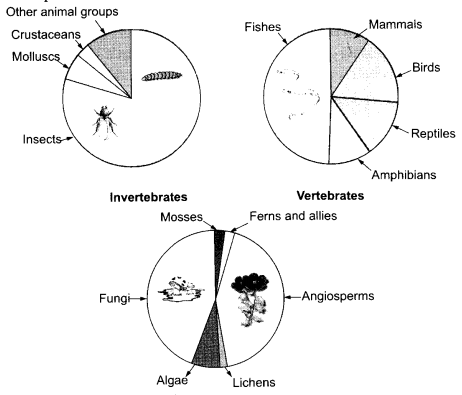
Observe the diversity carefully and answer the questions that follow:
(1) Identify the most endangered group of plants among all the categories.
(2) What may be the reason behind such a less population of mosses and ferns?
(3) Name the most advanced and the most primitive group of plants in a biodiversity given above.
(4) Fungi, inspite of being heterotroph are able to sustain themselves as a large population. Explain.
OR
With the help of a flowchart explain what are the various major approaches to conserve biodiversity?
Question 25.
The graph given below is representing the reproductive cycle in females. Analyse the graph in regard of a normal menstrual cycle and answer the questions given below.
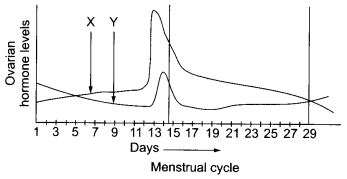
(1) Identify the hormones marked as ‘X’ and ‘Y’
(2) Explain the ovarian phases during menstrual cycle.
(a) 5th day to 12th day of the cycle.
(b) 14th day of the cycle.
(c) 16th day to 25th day of the cycle.
(3) What influence does hormones ‘X’
OR
Male and female gametes in human beings differ from each other in both structure and function. Enumerate some major differences between the two.
Question 26.
A single mutant allele is responsible for the abnormal formation of haemoglobin (i.e. Hbs). If it is present in a homozygous state (HbsHbs), son develops a sickle cell anemia while shows few symptoms if it is found in a heterozygous state (HbAHbs). On the basis of the above situation, work out a cross supposing a condition in which a woman’s mother homozygous for allele marries a male who is heterozygous for the allele. Indicate the probability of having a normal or a diseased child for each of her pregnancy.
OR
Haemophilia and colour blindness are sex-linked recessive disorders being determined by the alteration or mutation in the single gene. Mention the pattern of inheritance of both disorders in human beings with a help of a cross.
Answers
SECTION-A
Answer 1.
Offsprings produced through asexual reproduction are genetically identical to each other as well as to their parents, while sexually produced offsprings show genetic variations leading to evolution.
Answer 2.
Homologous organ. Divergent evolution has brought such a similarity in them.
Answer 3.
Honey and Beeswax.
Answer 4.
Gel electrophoresis.
Answer 5.
Change of frequency of allele in a population will result in natural selection leading to the evolution.
SECTION-B
Answer 6.
Brinjal has chasmogamous flowers, as they are open with exposed stamen and stigma. Such flowers show cross pollination as well as self-pollination. On the other cleistogamous flowers, as they never open, even at maturity, show self-pollination.
Answer 7.
Inheritance of flower colour in Antirrhinum majus.
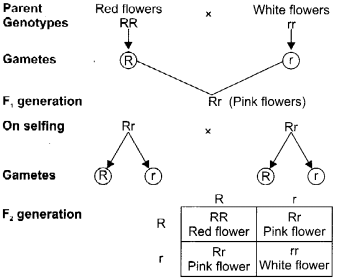
The above pattern shows law of independent assortment which states that when two pairs of traits are combined in a hybrid, segregation of one pair of characters is independent of the other pairs of characters
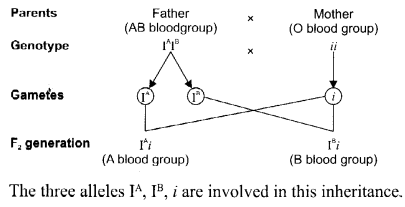
Answer 8.
Symptoms of amoebiasis are:
(a) Abdominal pain
(b) Stools with excess mucus
(c) Constipation
Causative organism is Entamoeba histolytica.
Answer 9.
During secondary treatment of primary effluents, vigorous growth of useful aerobic microbes into floes occur when it is agitated mechanically and air is pumped into it in a large aeration tank. These microbes, while growing, consume major part of organic matter in the effluent which reduces BoD.
Answer 10.
According to Hugo de Vries speciation is caused due to sudden mutations in existing population which are directionless and random.
SECTION-C
Answer 11.
Biogas plants are most suitable and advantageous in rural areas because of the following reasons:
- Raw material for biogas plant is mainly cow dung which is available in plenty in rural areas where cattle are used.
- Biogas is used for lighting and cooking in these areas as distribution is only in short distances.
- The spent slurry from the biogas plant is used as a fertiliser for, agriculture, hence are more suitable in rural areas.
Answer 12.
Three measures to control the vehicular air pollution are
- Reducing the use of fossil fuels.
- Use of catalytic converters, electrostatic precipitators and other control devices.
- Plantation of more trees especially the ones which accumulate pollutants and filters the air.
Answer 13.
Amoebiasis is caused by Entamoeba histolytica.
Symptoms.
(1) The patient passes out blood and mucus with stools.
(2) He also experiences griping pain in the abdomen with a fever.
Mode of transmission is usually through faecal and oral route, by sexual transmission or by vectors such as flies, cockroaches, etc.
Answer 14.
Differences between DNA and RNA
| DNA | RNA |
| It is the known genetic material found in all the organisms. | It is the known genetic material found only in some viruses. |
| Tt is mainly double-stranded with the exception of some viruses, (e.g. φ x 174) | It is mainly single-stranded with the exception of some viruses (e.g. double stranded in Retrovirus) |
| The sugar found is deoxyribose. | The sugar found is ribose. |
| Nitrogenous bases present are adenine, guanine, thymine and cytosine. | Nitrogenous bases present are adenine, guanine, thymine and uracil. |
| It is chemically less reactive and structurally more stable. | It is chemically more reactive and structurally less stable. |
| It has the ability to replicate itself. | It is formed by DNA. |
(1) Molecule ‘X’ synthesized by ‘i’ gene is a repressor protein. It gets inactivated on combining with an inducer molecule.
(2) Z gene.
(3) Transcription of gene stops in the following conditions:
- When substrate lactose is not available.
- And when energy source i.e. glucose is available to the cells.
Answer 15.
GMO stands for Genetically Modified Organism.
In order to produce a hybrid we need a cross between genome of two species of strain. While, in case of GMOs, foreign genes are introduced in an organism and is usually maintained as an extra-chromosomal entity or gets integrated into the genome of an organism.
Answer 16.
Adaptive radiation is known as the process of evolution of different species in a given geographical area starting from a point and literally radiating to the other areas of the habitat. For example, many Australian marsupials, different from each other, such as kangaroo, sugar glider, etc had evolved from a common ancestral stock, but all within the Australian continent. Thus, when more than one adaptive radiation occur in an isolated geographical area, Convergent evolution is said to occur.
Likewise Australian placental mammals also shows adaptive radiation in evolving into varieties of such placental mammals. Each one of these appear similar to the corresponding marsupial, e.g. placental wolf and Tasmanian wolf, anteater and numbat, etc.
Answer 17.
Before the generation of new plants through the plant breeding programmes, they need to be evaluated for their yield and other agronomic traits of quality, disease resistance etc.
This testing is done on the farmer’s field itself for atleast three growing seasons, at different locations in the country representing all the agroclimatic zones, where the crop is usually grown. The material is then evaluated in comparison to the best available local crop cultivar known as a check or a reference cultivar.
Answer 18.
(1) Zygote, a diploid cell is formed as a result of fusion of male and female gametes.
Its development depends on the following two main conditions:
(a) A type of life cycle of the organism
(b) Environment to which it is exposed to
(2) If the number of chromosomes present in meiocyte (2n) is 24,
Then, the number of chromosomes in gamete will be (n) = 12.
Number of chromosomes in zygote (2a?) will be = 24
And the number of chromosomes in an embryo (2n) will be = 24
Answer 19.
(1) Fermentation is known as the process of conversion of carbohydrates to alcohol and CO2 with the help of microbes such as bacteria and yeast. Microbes via fermentation are utilised for the synthesis of number of products that are valuable for human beings.
(2) Some of the important applications of microbes are
- In the production of bread using baker’s yeast.
- To ferment fish, soyabean, bamboo shoots, etc.
- To produce different varieties of cheese by fermentation.
- To produce wine, beer and other alcoholic drinks by fermentation.
- In the production of vinegar.
Answer 20.
Bt toxin genes were isolated from the bacterium Bacillus thuringiensis and was incorporated into several crops like cotton, tomato etc.
The choice of the genes depends on the crop and the targeted pest, as most Bt toxins are insect group specific. This toxin is coded by a gene named ‘cry’, e.g. Gene cry IAc and cry IIAb control cotton bollworms and that of cry IAb controls com borer.
Answer 21.
(1) The given pyramid is a spindle shaped ecological pyramid. The base and the apex of this pyramid is representing the producer (1st trophic level) and tertiary level consumer respectively.
(2) Examples of such ecological pyramid are:
(a) Pyramid of number in a tree ecosystem,
(b) Pyramid of biomass in a lake.
Answer 22.
Branching descent is the ability of different species adapted to different habitat which come from common ancestors, e.g. Darwin’s finches varieties arise from grain eaters. Australian marsupials evolved from common marsupials.
Natural selection is a process in which heritable variations help in the survival of an organism and enable them to reproduce and produce large number of off springs. There may be change in the frequency of genes and alleles in the future generations. It leads to the formation of a new species, e.g. evolution of marsupials of Australia from common ancestor.
SECTION-D
Answer 23.
Neeta told her mother that in spite of living in such an educated society, the awareness among our people has not yet reached to that extent which is actually needed. Thus, the forceful and constant reminding is eventually required. She also explained her mother that due to this unawareness, our country is becoming over-populated and number of AIDS related cases are increasing constantly.
Apart from the unprotected sexual contacts, AIDS can also spread due to following other reasons as:
- Use of contaminated razors or other instruments used for piercing different body parts, e.g. pinna.
- Transfusion of infected blood or blood products.
- Organ transplant
- Parturition, etc.
Hence, it is not shameful to discuss about AIDS/HIV and ways to control it.
SECTION-E
Answer 24.
1. Mosses are the most endangered group of plants.
2. Population of mosses and ferns is less due to the following reasons:
- Environment pollution
- Increase in urbanization
- Habitat destruction
- Expansion in agriculture
3. Angiosperm and algae respectively are the most advanced and primitive group of plants in a given biodiversity.
4. Fungi are heterotrophic in nature due to the lack of chlorophyll. They are able to sustain themselves as a large population because of their ability of reproducing both asexually and sexually.
OR

Tn-Situ
In-Situ conservation involves the protection of species in their natural habitat:
- Biodiversity hotspots are the region of high levels of species richness and high degree of endemism (that is species confined to that region and not found anywhere else). The total number of biodiversity hotspots are 34. Three hotspots, which cover India are Western Ghats/ Sri Lanka, Indo-Burma and Eastern Himalaya.
- Protected areas are ecologically rich and biodiversity rich regions. India has 14 Biosphere Reserves, 90 National Parks and 449 Wildlife Sanctuaries. The first National Park set up in Tndia was Jim Corbett National Park.
Ex-Situ
- Protection of gametes can be done by storing material in the places where stocks remain viable for a longer period of time without harming their genetic variability.
- Protection of threatened species comes under the category of off-site collections of various wild and domesticated species. India has around 2,75,200 parks where animals which have become extinct in wild are maintained and has around 35 botanical gardens to collect, cultivate and display various different varieties of plant species.
Answer 25.
(1)Hormone ‘X’ is Luteinising Hormone (LH).
Hormone ‘Y’ is Follicle Stimulating Hormone (FSH).
(2) (a) Follicular phase (proliferative phase)
(b) Ovulatory phase (release of ovum).
(c) Luteal phase
(3) (a) FSH is secreted by the anterior pituitary, which stimulates the ovarian follicle to secrete oestrogen, which in turn stimulates the proliferation of the endometrium of the uterine wall.
(b) Both LH and FSH attain a peak level in the middle of cycle (about 14h day). Rapid secretion of LH leading to its maximum level during the mid-cycle is called LH surge which induces the rupture of Graafian follicle’and thereby the release of an ovum (ovulation).
(c) The remaining cells of ovarian follicles are further stimulated by the LH to develop corpus luteum which secretes large amount of progesterone, a hormone essential for the maintenance of an endometrium.
OR
| Male Gamete (Sperm) | Female Gamete (Ovum) |
| Male gamete (Sperms) are produced inside the testes. | Female gamete (ova) are developed inside the ovaries. |
| The maturation of sperms requires about 64 days. | The maturation of ova requires several years. |
| Millions of sperms are produced per day. | Only one ovum matures every 28 days. |
| Sperms are motile in nature. | Ovum is non-motile in nature. |
| Reserve food material is less | Reserve food material is sufficient. |
| A sperm is differentiated into four parts, i.e. head, neck, middle piece and tail. | Ovum is not differentiated into different parts. |
Answer 26.
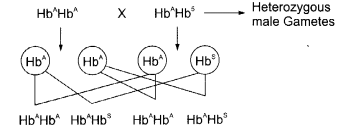
50% Homozygous for the Hbs allele.
50% Heterozygous for both Hbs and HbA allele.
Above cross shows that a child has the equal probability of developing into a normal child or with some symptoms of the disease. This therefore, proves that a woman has no risk of giving birth to a child everytime she conceives.
OR
Haemophilia is a blood disorder which in majority cases transmitted from an unaffected carrier female to some of the male offsprings. The gene for haemophilia is located on the X-chromsome. The possibility of female becoming haemophilic is extremely rare:

This indicates that for a female to become haemophijlic in a homozygous condition, mother of such female should be carrier and a father should be haemophillic.
Colour blindness, on the other hand, is the inability to distinugish among some or all colours. In this disorder, mutant forms of genes changes the light absorbing capacity of sensory receptors inside the eyes. This trait is mainly common in men, but heterozygous women may also shows symptoms and passes on the disorder to some of her sons.
Colour blindness, like any other disorder may also shows a criss-cross inheritance, i.e., it transmits from father to his daughter and from mother to her son.
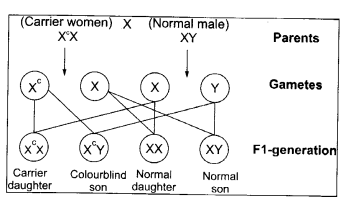
We hope the CBSE Sample Papers for Class 12 Biology Paper 4 help you. If you have any query regarding CBSE Sample Papers for Class 12 Biology Paper 4, drop a comment below and we will get back to you at the earliest.
